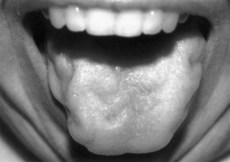69 Motor neuron disease
Salient features
Examination
• Fasciculations, absent reflexes and weakness in the upper limbs (see Fig. 62.1)
• Spasticity, exaggerated reflexes and upgoing plantars in lower limbs
• Sluggish palatal movements, absent gag reflex, brisk jaw jerk
• Check the tongue for fasciculations (Fig. 69.1)
• Check neck muscles; head droop is seen when there is weakness of the thoracic and cervical paraspinal muscles
Advanced-level questions
What are the symptoms attributable to motor neuron disease?
What are the characteristic features of this disease?
• It rarely begins before the age of 40 years
• Presence of upper and lower motor neuron involvement of a single spinal segment, and motor dysfunction involving at least two limbs or one limb and bulbar muscles
• Sensory symptoms or signs are not seen
• Ocular movements are not affected
• There are never cerebellar or extrapyramidal signs
• Sphincters are involved late, if at all
• Remission is unknown and the disease is fatal within 5 to 7 years (caused by bronchopneumonia).
What are the clinical patterns of motor neuron disease?
• Bulbar: bulbar or pseudobulbar palsy (in 25%)
• Amyotrophic lateral sclerosis (ALS; in 50%): flaccid arms and spastic legs
• Progressive muscular atrophy (in 25%): a lesion in the anterior horn cells affecting distal muscles. Characteristically there is retention of deep tendon reflexes in the presence of severe muscular atrophy
• Primary lateral sclerosis (rare): signs progress from an upper motor neuron to a lower motor neuron type
• Others conditions affect lower motor neurons:
What are the other types of motor neuron disease?
• Madras motor neuron disease, common in southern India, where the onset is early (before the age of 30), with asymmetrical limb weakness and wasting; bulbar and facial involvement occurs along with sensorineural deafness. The course is more benign than the disorder observed in Europe and America (Srinivas K, Jagannathan K, Valmikinathan K. The spectrum of motor neuron disease in Madras. In Rose FC (ed.) Research Progress in Motor Neuron Disease. London: Pitman, 1984, p. 142).
• ALS associated with a parkinsonism–dementia complex in Guam (Science 1987;237:517). It also tends to have an earlier onset and a more protracted course than the sporadic cases seen in Europe and America.
What are the criteria for diagnosis of amyotrophic lateral sclerosis?
Summary of revised El Escorial criteria:
• Definite: lower motor neuron and upper motor neuron signs in three regions
• Probable: lower motor neuron and upper motor neuron signs in two regions
• Probable with laboratory support: lower motor neuron and upper motor neuron signs in one region or upper motor neuron signs in one or more regions with electromyography evidence of acute denervation in two or more limbs
• Possible: lower motor neuron and upper motor neuron signs in one region
• Suspected: lower motor neuron signs only in one or more regions or upper motor neuron signs only in one or more regions.








